The Dark Past of Santa Claus
We all know that the prototype of Santa Claus is a Christian Saint Nicholas the Wonderworker. During the spread and flourishing of Christianity, this image was merged with the old pagan gods of winter and the New Year, for more quick and easy integration of the new religion among the common people.
Many Northern peoples associated the god of winter with withering and death, and it often had the image of old humanoid creature. The winter was always a time of severe trials, severe weather, eternal cold and darkness and such were the gods personifying this time of the year- heartless and harsh.
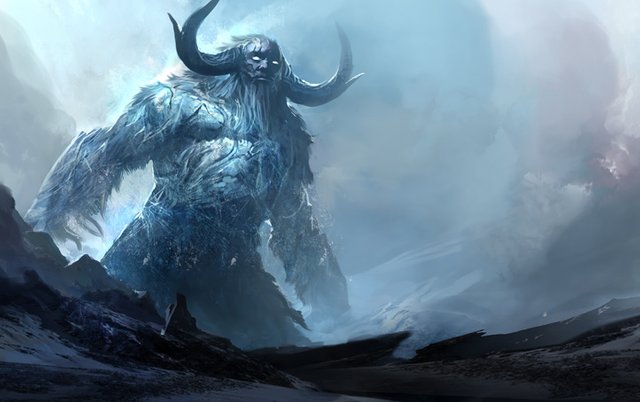
image source
Today the official residence and place of origin of Santa is a small village in Finland (Joulupukin Pajakylä). Finns, in turn, called Santa Joulupukki, which means Christmas goat. In our days this character similar to Santa, but let's find out where it came from...
Far Far North
Many tribes, having settled in Lapland had adopted the customs, traditions and legends of the people, who lived on this land for centuries - the Sami. And Joulupukki also was passed to them by inheritance, he was (or is) one of the most feared creatures in mythology.
Joulupukki was the God of winter, the Forests and the night. He appeared to people in the guise of a huge creature with goat horns, was rising above the trees and didn’t hesitate to eat people, to warm up with help of their warm blood. The ancient pagans on the last day of winter brought to him in the sacrifice of young men.
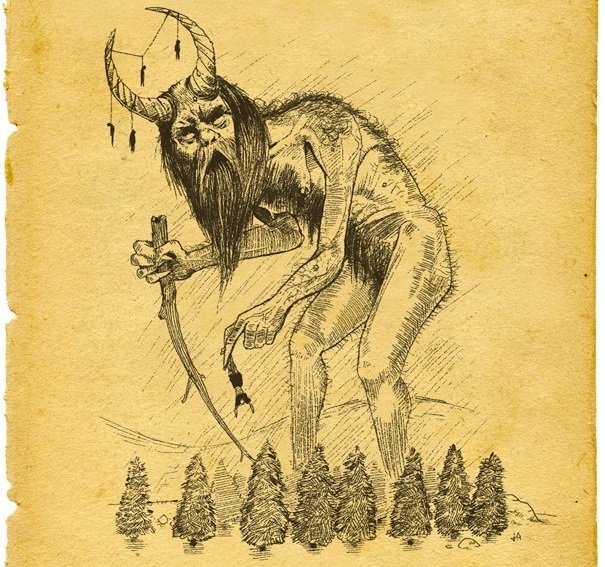
image source
On December 21-22 is the winter solstice, the longest night of the year, after which daylight begins to widen again, which is why this day is considered the beginning of the New Year.
The victim was tied to fir tree, was disemboweled and his internal organs hung on a tree branch, the tree trunk was completely daubed in the victim's blood. So the heathen fed Joulupukki before he went to sleep, that he slept as tightly as possible and didn't prevent to the arrival of spring and summer by his awakening.
The fir tree was chosen as the sacred tree not by chance, its evergreen view symbolizes immortality. It was considered that in these trees lives a wood spirit, or they are entrance into his world.
During a hard frost, the trees burst, literally, because the liquid inside the barrel greatly expanded. Ancient people believed that the crackling of the trees indicates the arrival of Joulupukki in our world.
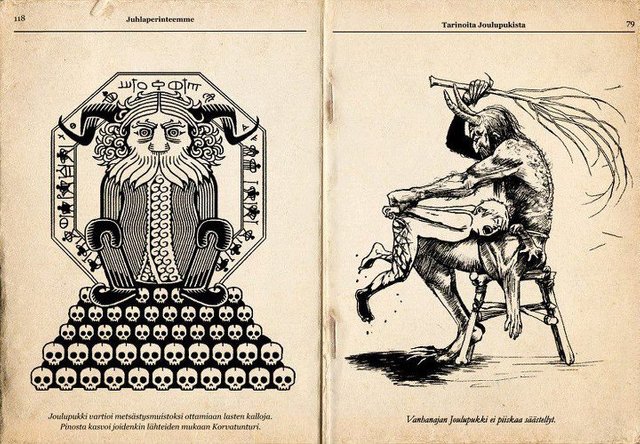
image source
Later, in the culture of Northern peoples, Joulupukki became more «civilized». From the God, which longed only to destroy people, he gradually turned into a deity with defined responsibilities.
Now it was almost human, or a demigod in human form, instead of clothes he wore a goatskin (bloody side out) with horns. His main goal was to get into the owner's house, get drunk and scare the kids.
Children who behave badly, he took to his home, where he beat them with rods to death, or boiled alive in a cauldron (a traditional way to scare kids and make them more manageable).

image source
About which kids are bad and which are good Joulupukki learned with the help of his servants dwarfs, who were sitting in the Echo caves and overheard the minds of children around the world. These caves are inside the hill of Korvatunturi, which is now officially Santa's village. The shape of the hill resembles the rabbit ears and allowing the dwarfs (elves) to hear the dreams and actions of children.
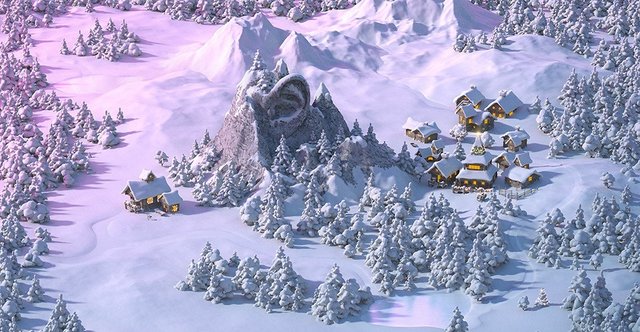
image sources
If the owners forgot to give him treats, then Joulupukki ate their reindeer, in his true form- a supernatural being, devoid of bone and blood, with hair to the ground, which hiding his insides from the human's eyes.
He had a wife Muori - the embodiment of darkness and cold, the flame was quenched, and the water was freezing when she was approaching.
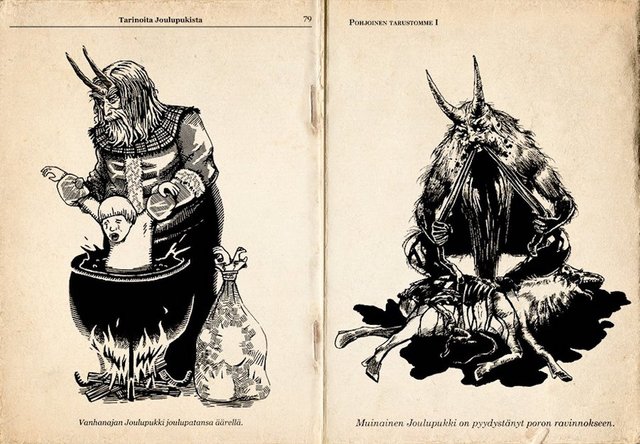
image source
Later, in the middle ages, Joulupukki turned just into an evil and harmful spirit, who lives under the floor in the kitchen. Traditionally, new year's eve you need to give him alcohol and cereal, then he would not destroy the house.
In the 19th century Joulupukki already looked like a man who dresses up in a goat. Before the new year he went home and checked was everything ready for the holiday or not (purely in the house, ready food, whether the owners of the house new clothes). People fed him biscuits and dumplings, to appease. If the goat was pleased with food and order in the house, would insure the owners good luck in the next year.
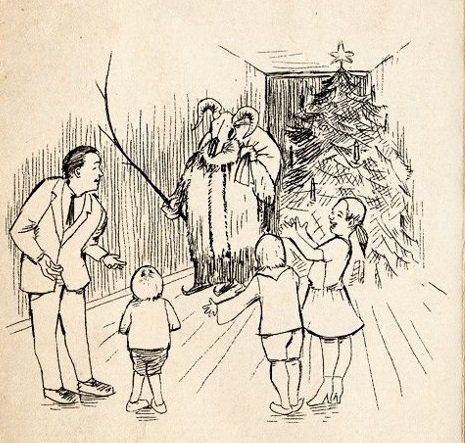
image source
The last image of Joulupukki, before he teamed up with Santa, has become nearly harmless (compared to its initial acts). By the end of the 19th century, he began not just check the house, but also giving gifts to the poor and needy and always paid special attention to children.
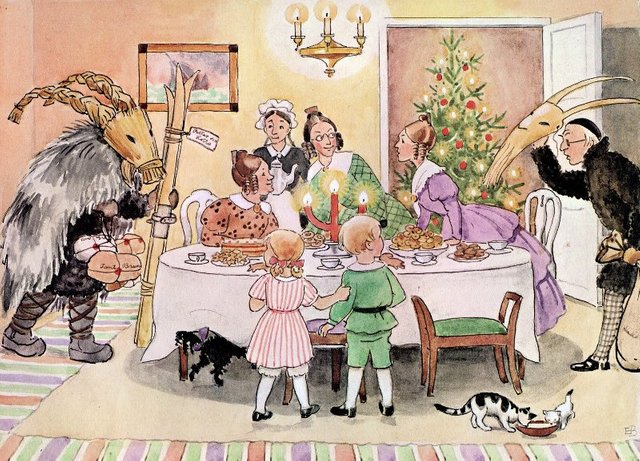
image source
The blood-stained goatskin, which he wore, turned into a red woolen robe, the goats separated from the original image and turned in transport, they were harnessed to his sleigh. He has only a small horns, as a reminder of his tricks and mischief.
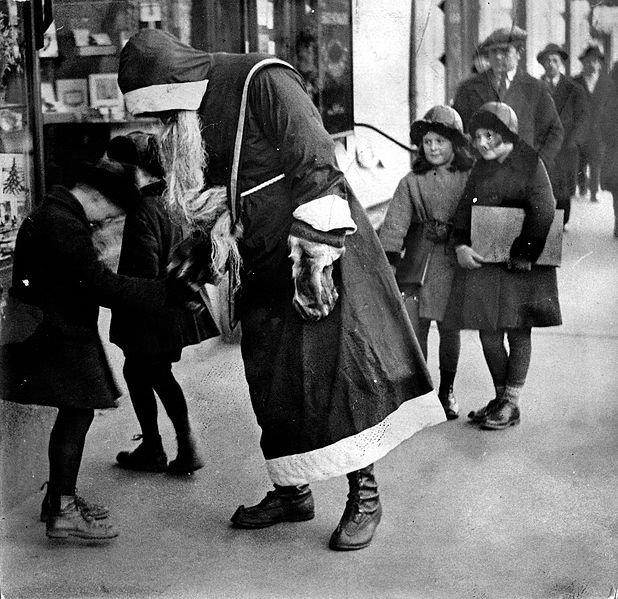
image source
After about 40 years, on the basis of this last image was created known around the world Santa Claus. The silver-haired grandfather with a long beard (goat's beard in the past), in a red robe (bloody side out goat skin), on sleigh with reindeer (which he ate before).
Christmas trees were decorated with bright toys (instead of the internal organs of the human victims). Elves, who spied on kids to steal them, now just respond to their letters. And the naughty kids just don't get gifts that they wanted, instead of being cooked in a cauldron. To obtain a good Santa, people spent a couple of thousand years.
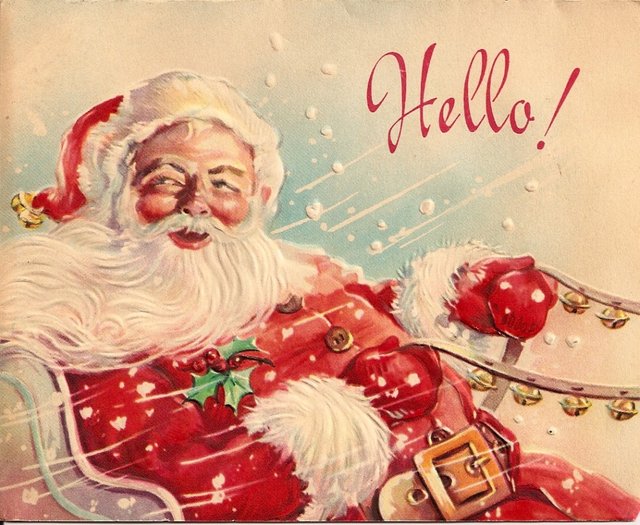
image source
sources: How Joulupukki the finnish Santa went from naughty to nice, Joulupukki WiKi, Yule Goat,Sami people, Sami Deities and Mythic Figures, Santa Claus a special thank for unique images for the film Rare Exports by illustrator Lauri Ahonen

don't forget that St. Nicholas is commonly linked to Odin, the ruler of Asgard, one of the major gods in Germanic mythology who was depicted as a white-bearded man with magical powers. However, Odin’s ties to Santa Claus may be more pronounced. The winter solstice, also known as Yule, was a time when Odin led a hunting party, known as the Wild Hunt, in the sky with an eight-legged horse named Sleipnir. The 13th century Poetic Edda said the mythical horse could leap great distances -- a trait reindeer possess. Children would leave their boots by the chimney filled with carrots and hay to feed Sleipnir. Legend has it that whenever Odin flew by he would leave gifts by their boots,
oh..and Krampus. Did you mention Krampus?
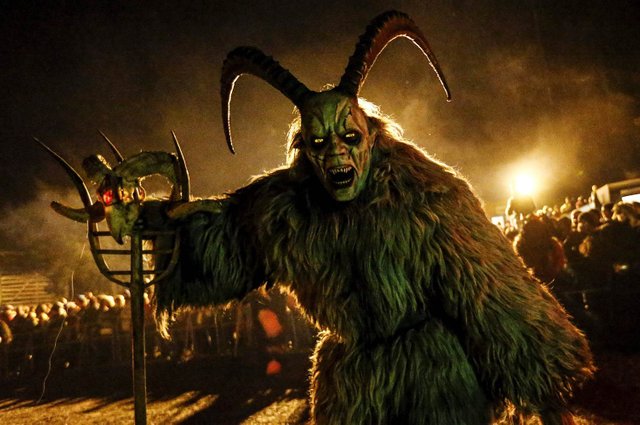
I know about the theory of the origin from Scandinavian mythology, it is also described in the link I pointed out, this theory is more popular because it also describes the history with goat and it was distributed among a larger population. You have described correctly.
but, Santa Claus is a collective image of various pagan gods, from which he also took over part of their traditions.
I am not confused Joulupukki with Krampus. Krampus appeared much later (mostly in fairy tales of German peoples). He is the opposite character to Santa, and not his "ancestor".
Actually Santa Claus in the West Scandinavian countries is more like the nisse/tomte. In Sweden Santa is called Jultomten, and in Norway and Denmark the nisse is more important than Santa. We put rice-porrige and beer up in the attic for him at Christmas (which we call Jul.)
But we also know the yulegoat. In Sweden it is made in straw and running yule goat mean to go from house to house and drink your brains out and play tricks on each other if you can stand.
Krampus is possibly also very old, but he is another story entirely. He belongs to the central European folklore especially the Alpine area. I had never heard of him before the opening of the Gotthard Tunnel.
Wow, very interesting to know that in present days in these countries, it's treated like a home spirit, brownie.
Krampus is really old, but still inferior in age creatures associated with Yule.
My home town has got the largest Yule Goat in Scandinavia, yay! :D
https://steemit.com/tradition/@oleg326756/the-great-straw-goat-of-gaevle-turns-50-this-week
The winter solstice, also known as Yule is present in the culture of many peoples, and it describes the different creatures. For example: Yule Cat, which is not associated with Odin and the Wild Hunt.
And we still call it Jul in Scandinavia. The older I get the less Christianity and the more paganism I see in the Scandinavian Christmas. In the North European Iron age it was very cold, a small ice-age, and people feared that the snow would not melt, that the summer would be cold and wet - and the famine that would follow. So every winter solstice you had a light feast. (I can't remember the name of the Goddess that was worshipped, she was pre-edda.) Today the Santa Lucia procession is a quasi Christian substitute for this. It is strangely emotional far beyond what you should expect. The complete darkness, the small, faint lights and the singing (which is a true Neapolitan tune in honour of the Roman saint :)
The cold climate is probably what was behind the mythic stories of Sol getting eaten by a wolf and the fimbul-winter that preludes the end of the world.
I believe that you are from the US Everitt, so maybe this is not all that interesting to you, but on this site you can see all the original Norse scriptures + all the old translations made in the Scandinavian languages. It's a great site that I have used a lot. I took the Old Norse text I used in this drawing from there.
Great post btw @natord!
A couple of days ago I wrote about the Nisse, another pagan god that has survived Christianity, and Gamer00 who is from Finland mentioned the Julebuk in a comment.
Thank you so much for sharing the link. Actually I was born in Murmansk (a city beyond the polar circle in Russia, near the border with Finland). I've always been interested myths of the North, probably because my mom read to me Edda and Kalevala in childhood :)
I follow you to don't miss intresting posts :)
I was born on the vast Cossack steppes in Southern Russia, close to Ukraine. My mom read Selma Lagerlöf’s and Astrid Lindgren’s books to me, when I was a child. So I ended up in Sweden as an adult. Life is funny…
Great post, I did not know any of this! You really explained all this well. It seems like people of the past were more ok with darker death than people are now.... then again, movies portray that all the time!
thank you @ballinconscious, i'm glad that you liked it :)
You are right, today we try to fight death and do not like to discuss it, people of the past treated it with more respect, as a part of life.
I did indeed thank you for posting this!
Yes, we are against death yet the economy/goverment support it with their military; A blind eye is turned when it come to this category.
That is true people of the past did seem to respect it as part of life but they also glorified it and overindulged in murder/sacrifices as a sacred thing! I can not see this as a positive thing from any perspective.
Great story for the season @natord, thanks... as for the Krampus I just heard of it last month in Austria!
Thank you for reading!:) it's great that you found out about it in the place of its origin, local can tell much more interesting traditions, than we can learn from Wikipedia.
It sure was prevalent in shops, town and the peoples minds.
Have been debating for some time now what i will tell my children about 'Father Christmas' when they are a bit older. I would like to tell them the facts, though I guess it would freak them out a bit! Thanks for the post. Very interesting.
You can add more hard facts gradually with the age :) I would have left the sacrifice in the end ;)
Haha, great post :)
Thank you :)
Great Post